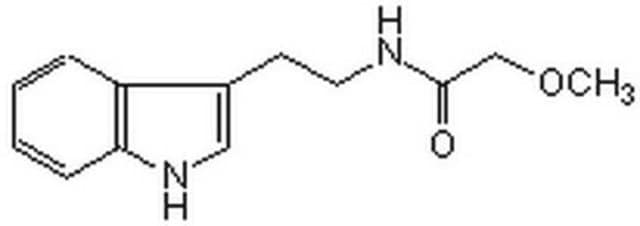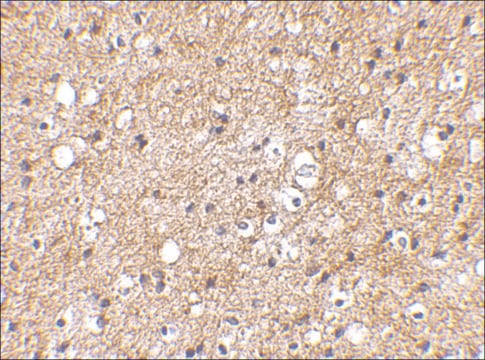PZ0115
CP-31398 dihydrochloride hydrate
≥98% (HPLC)
Synonim(y):
N′-[2-[2-(4-Methoxyphenyl)ethenyl]-4-quinazolinyl]-N,N-dimethyl-1,3-propanediamine dihydrochloride hydrate
About This Item
Polecane produkty
Próba
≥98% (HPLC)
warunki przechowywania
desiccated
kolor
yellow
rozpuszczalność
H2O: ≥20 mg/mL
temp. przechowywania
2-8°C
ciąg SMILES
O.Cl.Cl.COc1ccc(cc1)\C=C\c2nc(NCCCN(C)C)c3ccccc3n2
InChI
1S/C22H26N4O.2ClH.H2O/c1-26(2)16-6-15-23-22-19-7-4-5-8-20(19)24-21(25-22)14-11-17-9-12-18(27-3)13-10-17;;;/h4-5,7-14H,6,15-16H2,1-3H3,(H,23,24,25);2*1H;1H2/b14-11+;;;
Klucz InChI
JXIVIAMOMIONKY-UWCBQFGESA-N
informacje o genach
human ... TP53(7157)
mouse ... TP53(22059)
rat ... TP53(24842)
Zastosowanie
- to evaluate its effects on the upregulation of miRNA in human neuroblastoma cells
- to study its effects on arsenic trioxide (ATO) stabilization of p53 folding
- to study its effects on regulation of miR-34 in PC12 cells
Działania biochem./fizjol.
Cechy i korzyści
Hasło ostrzegawcze
Warning
Zwroty wskazujące rodzaj zagrożenia
Zwroty wskazujące środki ostrożności
Klasyfikacja zagrożeń
Acute Tox. 4 Oral - Aquatic Chronic 4 - Eye Irrit. 2 - Skin Irrit. 2
Kod klasy składowania
11 - Combustible Solids
Klasa zagrożenia wodnego (WGK)
WGK 3
Temperatura zapłonu (°F)
Not applicable
Temperatura zapłonu (°C)
Not applicable
Certyfikaty analizy (CoA)
Poszukaj Certyfikaty analizy (CoA), wpisując numer partii/serii produktów. Numery serii i partii można znaleźć na etykiecie produktu po słowach „seria” lub „partia”.
Masz już ten produkt?
Dokumenty związane z niedawno zakupionymi produktami zostały zamieszczone w Bibliotece dokumentów.
Produkty
Cell cycle phases (G1, S, G2, M) regulate cell growth, DNA replication, and division in proliferating cells.
Apoptosis regulation involves multiple pathways and molecules for cellular homeostasis.
Nasz zespół naukowców ma doświadczenie we wszystkich obszarach badań, w tym w naukach przyrodniczych, materiałoznawstwie, syntezie chemicznej, chromatografii, analityce i wielu innych dziedzinach.
Skontaktuj się z zespołem ds. pomocy technicznej![[Pyr1]-Apelin-13 trifluoroacetate salt ≥96% (HPLC)](/deepweb/assets/sigmaaldrich/product/images/391/809/a864cd5a-3260-42cf-93ae-cb4754f4e4ad/640/a864cd5a-3260-42cf-93ae-cb4754f4e4ad.jpg)









